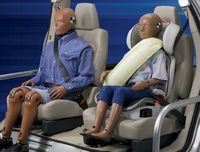Ford Mondeo Introduces Inflatable Seatbelts, a Ford First for Australian Customers
SYDNEY – Aug 13, 2013: Ford’s new rear inflatable seat belts, combining attributes of traditional seat belts and airbags, will provide an added level of crash safety protection for rear seat occupants when they are introduced in the all-new Mondeo in the second half of 2014.
The advanced restraint system is designed to help reduce head, neck and chest injuries for rear seat passengers, often children and older passengers who can be more vulnerable to such injuries. Ford’s rear inflatable seat belt technology will enhance safety for rear seat passengers of all ages, especially for young children who are more vulnerable in crashes. “Our families are our most precious cargo and this family friendly technology provides some peace of mind for parents and their rear seat passengers,” according to Bob Graziano, Ford Australia President and CEO. Although seatbelt usage in Australia is among the highest in the world, studies show that drivers and front seat passengers are 5 times more likely to die in an accident if the rear passengers are not wearing seatbelts, particularly in the case of head-on collisions. In an accident, unbuckled rear passengers are at risk of becoming human missiles and colliding with other occupants.
Safer and more comfortable
Advances in airbag inflation and
seat belt construction methods have enabled Ford and its suppliers to
develop inflatable seat belts that are designed to deploy over a vehicle
occupant’s torso and shoulder in 40 milliseconds in the event of a
crash. In everyday use, the inflatable belts operate like conventional seat
belts and are safe and compatible with infant and children safety car and
booster seats. In Ford’s research, more than 90 per cent of those who
tested the inflatable seat belts found them to be similar to or more
comfortable than a conventional belt because they feel padded and
softer.
In the event of a frontal or side crash, the inflatable belt’s increased diameter more effectively holds the occupant in the appropriate seating position, helping to reduce the risk of injury.
Vehicle safety sensors determine the severity of the collision in the blink of an eye and deploy the inflatable belts’ airbags. Each belt’s tubular airbag inflates with cold compressed gas, which flows through a specially designed buckle from a cylinder housed below the seat.
The inflatable belt’s accordion-folded bag breaks through the belt fabric as it fills with air, expanding sideways across the occupant’s body in about the same amount of time it takes a car traveling at highway speed to cover one metre. The use of cold compressed gas instead of a heat-generating chemical reaction – which is typical of traditional airbag systems – means the inflated belts feel no warmer on the wearer’s body than the ambient temperature.
The inflatable belts also fill at a lower pressure and a slower rate than traditional airbags, because the device does not need to close a gap between the belt and the occupant. The inflated belt helps distribute crash force energy across five times more of the occupant’s torso than a traditional belt, which expands its range of protection and reduces risk of injury by diffusing crash pressure over a larger area, while providing additional support to the head and neck.
After deployment, the belt remains inflated for several seconds before dispersing its air through the pores of the airbag.
Ford’s safety leadership record continues to grow
The
inflatable seat belt continues Ford’s record of safety innovation as
the company strives to make driving even safer for Ford customers.
Ford was the first automaker to introduce seat belts in 1955 and led the way in making driver and front passenger airbags standard in most vehicles by 1993.
Among the newest safety systems available to Ford customers in Australia is Emergency Assistance, which has just been launched on the Ford Kuga, Ford Fiesta ST and Focus ST. Emergency Assistance delivers a critical voice message directly to 000 operators, indicating that a vehicle has been involved in an accident in which the vehicle’s airbags have been deployed and opens the line for hands-free communication.
The Ford SYNC Emergency Assistance system uses the driver’s own mobile phone via Bluetooth and runs in the background once the system is switched on and the phone is properly paired with SYNC and is within mobile phone range.
After the one-time setup, the phone connects with SYNC every time the driver enters the vehicle with his or her phone and the phone is turned on and Bluetooth is activated.
Should an accident occur in which an airbag deploys or the emergency fuel pump shutoff is activated, the feature uses SYNC hands-free phone capabilities to connect the driver directly with a 000 operator through the paired phone.



